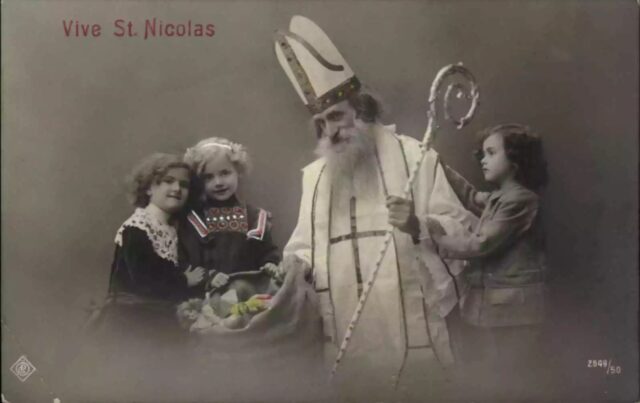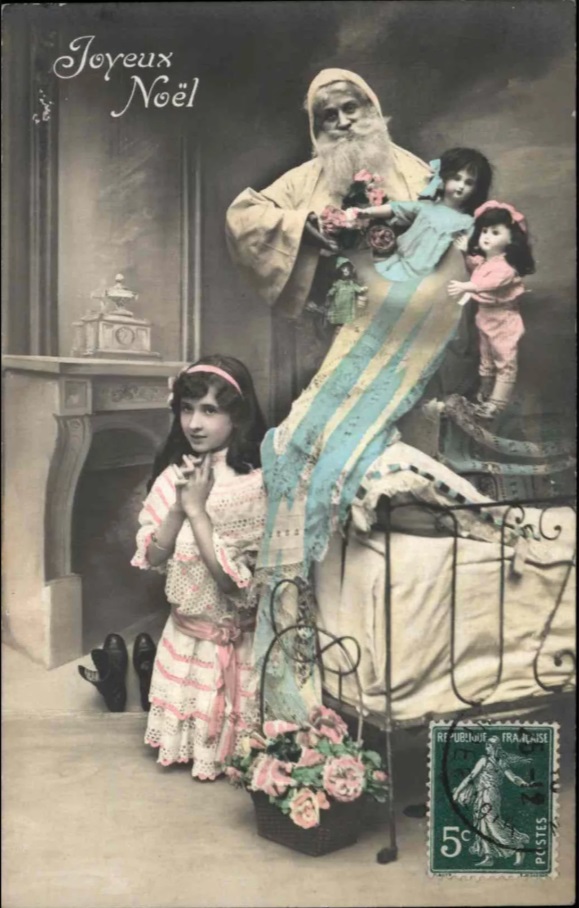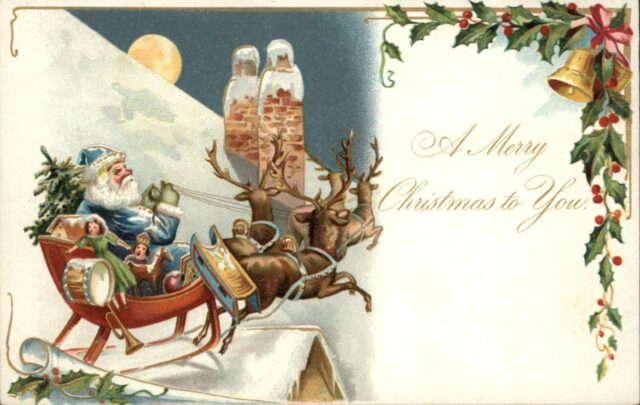 Christmas is, and always has been, my favorite holiday. Having been born in the fifties, my visual of Santa was a jolly, rotund gentleman with a full white beard, dressed in red. He had a team of eight reindeer capable of flying. They soared over neighborhoods while pulling Santa and his sleigh filled with presents and goodies. They landed on rooftops and patiently waited while Santa slid down the chimneys to fill the stockings of each deserving child, and place gifts around the Christmas tree.
Christmas is, and always has been, my favorite holiday. Having been born in the fifties, my visual of Santa was a jolly, rotund gentleman with a full white beard, dressed in red. He had a team of eight reindeer capable of flying. They soared over neighborhoods while pulling Santa and his sleigh filled with presents and goodies. They landed on rooftops and patiently waited while Santa slid down the chimneys to fill the stockings of each deserving child, and place gifts around the Christmas tree.
I remember, at a very young age, being so careful to be on my best behavior as the 25th of December grew closer… I wanted to be sure that Santa would leave presents under my tree and not a lump of coal in my stocking! I can recall anxiously waiting in my bed on Christmas Eve and each little sound I heard was surely a portent of Santa’s arrival.
It wasn’t until I was much older that I discovered there were multiple depictions of Santa Claus, who was primarily recognized in the United States. I learned more about the various versions of Santa that were depicted on postcards from all over the world. He appeared in many forms over the years, beginning as a religious figure (St. Nicholas) in the 3rd century, before morphing into Father Christmas, Kris Kringle, and finally Santa Claus, the “jolly old elf” we know today.
Old postcards have become an invaluable map for following the trajectory of “Santa” down through the ages. They tell the story of continents and countries, and cover about 160 years. Most of these postcards were produced between the 1870s into the 1920s, but they can be traced back to the 1840s and continued to be popular into the 1950s, ‘60s and ‘70s.
St Nicholas, Sinterklaas, and Santa Claus

Saint Nicholas was the original inspiration for Santa Claus, based on the real-life Christian bishop Nicholas of Myra. He was the patron saint of many. Very little is known about him, but history claims he was the son of wealthy Christian parents, born in the small seaport of Patara, Lycia, in Asia Minor (now known as Turkey). Most of the stories that are told of his life were written long after his death. He became known for his love for children, his concern for sailors and ships, and his generosity to those in need. The anniversary of his death, December 6th, became a day of remembrance and celebration… Saint Nicholas Day.
Sinterklaas was the Dutch name for Saint Nicholas, and was brought to the American colonies by Dutch families in the 17th century. The name Sinterklaas became Santa Claus to the English-speaking majority of the early United States.
Father Christmas (Europe)

Father Christmas is the traditional English name for the personification of Christmas. Although now known as a Christmas gift-bringer, and typically considered to be synonymous with Santa Claus, he was originally part of a much older and unrelated English folkloric tradition. He first appeared in the mid 17th Century after the English Civil War. The Puritan-controlled English Government attempted to abolish Christmas and outlawed its traditional customs. The Royalist political party adopted Old Father Christmas as the symbol of ‘the good old days’ of feasting and good cheer, linking the old traditions with their cause. His character was maintained during the late 18th and into the 19th century by the Christmas folk plays later known as mummer plays.
Pere Noel (France)

In France (and other French-speaking Territories) Pere Noel was another legendary gift-bringer at Christmas, similar to Father Christmas and Santa Claus. According to tradition, on Christmas Eve children leave their shoes by the fireplace filled with carrots and treats for Père Noël’s donkey, Gui (French for “Mistletoe”) before they go to bed. Père Noël takes the offerings and, if the child has been good, leaves presents in their place. The presents were traditionally small enough to fit in the shoes: candy, money or small toys.
Santa Claus (United States, 18th – 20th Century)
On Dec. 23, 1773 in New York City, Santa Claus first appeared in print with an announcement by Rivington’s Gazetteer that “Last Monday the anniversary of St. Nicholas, otherwise called Santa Claus, was celebrated at Protestant Hall . . . where a great number of sons of that ancient saint celebrated the day with great joy and festivity.” According to the excellent article “The 18th Century Politics of Santa Claus in America” on St Martin’s The History Reader website, the roots of Santa at this time were tied to the many immigrants from nations around the world working to preserve their own cultural identity in a confusing and rapidly changing world.
In the aftermath of the American Revolution, he stayed. Washington Irving incorporated St. Nicholas into his 1809 “History of New York.” He is portrayed as “riding over the tops of the trees, in the same wagon that he uses to bring his yearly presents to children.” In 1822 Clement Clark Moore, an acquaintance of Irving, wrote “An Account of a Visit from St. Nicholas,” better known today by its very first line “Twas the Night Before Christmas.” He portrayed St. Nick with twinkling eyes and a rotund build, smoking a pipe as he rode across the treetops.

On Christmas of 1866, American artist Thomas Nast portrayed Santa Claus as an American in spite of the fact that he lived at the North Pole. So the modern Santa Claus we know, with his sleigh and his reindeer, (despite his roots in the historical St. Nicholas who lived in what is now Turkey) became an American.
Santa Claus and the Coca Cola Connection
Coca-Cola was invented in 1886 by Dr. John S. Pemberton, an Atlanta Pharmacist. Cocaine was one of the ingredients in the first Coca-Cola, so, not surprisingly many Americans became addicted to it. The formula was eventually remedied, but Coca-Cola is still the most popular soft drink in the US today.
What Coca-Cola represents to Americans is part of its appeal. It became a symbol of American culture after World War II, during the age of Imperialism. It also became a symbol of American Christmas. Santa has been featured in the Coca-Cola ads since the 1920s, but in 1931 the company’s collaboration with illustrator Haddon Sundblom helped solidify the modern image of Santa. Sundblom’s paintings depicted Santa with features like rosy cheeks, a white beard, and twinkling eyes.

The ads that were created representing the beverage primarily targeted younger audiences and children. Their use of Santa Claus and other images of Christmas in window displays and commercials sent a powerful message to adults and children alike. Although Coca-Cola doesn’t have any health benefits, and does have some potentially negative repercussions (cavities, diabetes, obesity) the amazing images they created for advertising invoked happy holiday memories.
Not surprisingly, the Coca-Cola images were also a very popular subject for postcards, especially around the Christmas holidays.

My Own Joy of Christmas
My absolute joy of Christmas has helped me hold a place in my heart for Santa. I was the oldest daughter in a family of five children. We didn’t have a lot of money, but we always managed to have a Christmas tree that our Dad would go out into the woods and cut down. We all helped to decorate it, and my Mom cooked all kinds of goodies. Our stockings were hung, and there were presents under the tree. I loved helping to plan for the holiday, and as I got older I was delighted to play a bigger role in the planning and execution of Christmas.
When I grew up and had my own family, a son and a daughter, I was thrilled to continue the traditions of my childhood with my children. I have been happy beyond measure to watch my daughter find the same joy that I do in the Holiday and share that joy with me. My son and my daughter-in-law have blessed me with two beautiful grand-daughters, and sharing Christmas with them is pure delight. And yes, there is a Santa Claus!




